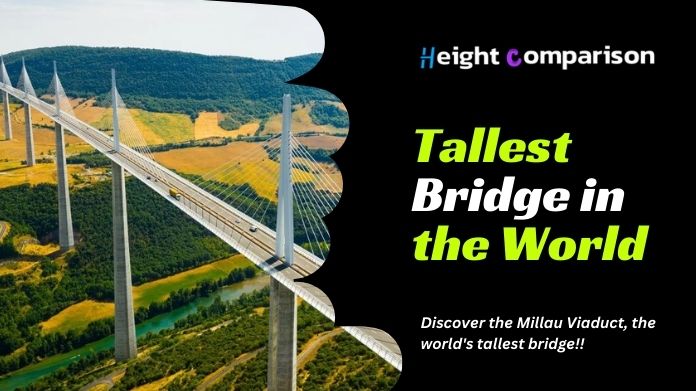The Millau Viaduct is an engineering marvel and a testament to human ingenuity, soaring gracefully across the Tarn Valley in southern France. As the tallest bridge in the world, it captures the imagination with its awe-inspiring height and elegant design.
Spanning the picturesque landscape, this architectural masterpiece has redefined possibilities in bridge construction, pushing the boundaries of engineering excellence.
With its towering pillars and sleek lines, the Millau Viaduct symbolizes progress and innovation, attracting visitors from around the globe to marvel at its beauty and technical prowess.
Join Height Comparison as we explore the fascinating story behind the creation of the Millau Viaduct and its significance in modern infrastructure.
Millau Viaduct: Tallest Bridge in the World

The Millau Viaduct, an architectural marvel nestled in the picturesque landscapes of southern France, stands as a symbol of human innovation and engineering excellence.
Towering over the Tarn Valley, it is the tallest bridge in the world, captivating spectators with its breathtaking height and sleek design. Designed to blend with its natural surroundings seamlessly, the viaduct’s graceful curves and soaring pillars create a striking silhouette against the sky.
As a testament to modern engineering prowess, the Millau Viaduct facilitates smoother travel. It is an iconic landmark, drawing visitors from far and broad to marvel at its beauty and creativity.
Join us as we delve into the awe-inspiring tale behind the construction of this extraordinary bridge and explore its significance in the realm of infrastructure and architecture.
| Information | Details |
|---|---|
| Location | Southern France |
| Coordinates | 44.0778° N, 3.0222° E |
| Area | Tarn Valley |
| Built Year | 2001-2004 |
| Built For | Enhancing transportation infrastructure |
| Dimensions | Length: 2,460 meters; Height: 343 meters |
| Architect | Norman Foster, Michel Virlogeux |
| Architectural Style | Modern, Cable-stayed bridge |
| No. of Visitors Every Year | Approximately 1.5 million |
| Governing Body | Government Property |
| UNESCO World Heritage Site | No |
| No. of Floors | N/A |
| Top Floor | N/A |
| Inaugurated By | President Jacques Chirac |
Historical Information
Origin and History
The Millau Viaduct was conceived to alleviate traffic congestion in the region and improve transportation infrastructure. The need for a direct route between Paris and Barcelona necessitated its construction.
Builders and Construction
The British architect Lord Norman Foster and French structural engineer Michel Virlogeux designed the viaduct. Construction started in 2001 and was completed in 2004, with the viaduct opening to traffic on December 16, 2004.
Purpose and Significance
The primary purpose of the Millau Viaduct is to facilitate smoother travel between northern and southern Europe, particularly between Paris and Barcelona. It has significantly reduced travel times and congestion on the A75 autoroute. Additionally, it serves as an architectural and engineering marvel, showcasing human ingenuity in bridge construction.
Physical Attributes
Location
The Millau Viaduct spans the Tarn Valley near Millau in southern France.
Dimensions
The viaduct is approximately 2,460 meters long and stands at 343 meters at its tallest point, making it the tallest bridge in the world.
UNESCO World Heritage Site
While the viaduct is not designated as a UNESCO World Heritage Site, it is recognized globally for its architectural and engineering excellence.
Architectural Details
Construction Materials
The viaduct primarily consists of steel and concrete, with the deck supported by seven concrete piers and cables.
Floors and Architectural Styles
The viaduct does not have traditional floors but features a single deck for vehicular traffic. Its architectural style is characterized by modern design principles, focusing on functionality and aesthetics.
Design Elements
The viaduct’s sleek and minimalist design, graceful curves, and towering pillars have earned it acclaim for its aesthetic appeal and structural integrity.
Cultural and Tourist Aspects
Cultural Significance
The Millau Viaduct has become an iconic symbol of modern engineering and a source of pride for the local community. It represents the region’s commitment to innovation and progress.
Tourist Popularity
The viaduct is a popular tourist attraction, drawing visitors worldwide who admire its impressive architecture and panoramic views of the surrounding landscape.
Associated Events
Various events and ceremonies have been held at the viaduct to celebrate its inauguration and milestones in its operation. It has also been featured in numerous films, documentaries, and cultural exhibitions.
Economic Aspects
Tourism Revenue
The viaduct generates revenue through tourism, as visitors pay tolls to cross it and access its observation areas.
Income Source
The primary income source for the viaduct is toll collection, which contributes to its maintenance and operation costs.
Conditions and Maintenance
Current Condition
The viaduct is in excellent condition and is set to withstand natural disasters such as earthquakes and high winds.
Maintenance Challenges
Regular maintenance is essential to ensure the viaduct’s safety and longevity. Challenges include inspecting and repairing cables, decks, and support structures and managing vegetation growth and erosion.
Recognition and Awards
Awards and Recognition
The Millau Viaduct has received numerous awards and accolades for its design, engineering, and environmental sustainability. These include the Outstanding Structure Award from the International Association for Bridge and Structural Engineering and the European Steel Design Award. Its innovative design and positive impact on the region have earned it national and international acclaim.
Final Note
The Millau Viaduct is an incredible feat of modern engineering, towering over the Tarn Valley and holding the title of the tallest bridge in the world. Its construction has significantly improved transportation infrastructure, providing a strong link between northern and southern Europe.
Beyond its practical purpose, the viaduct is celebrated for its architectural elegance and innovative design, earning recognition and accolades on a global scale.
As a symbol of human ingenuity and progress, the Millau Viaduct inspires awe and admiration, drawing tourists from far and wide to marvel at its towering pillars and sweeping curves.
With its enduring legacy and ongoing contribution to the region’s economy and cultural identity, the Millau Viaduct remains an iconic landmark of engineering excellence.






